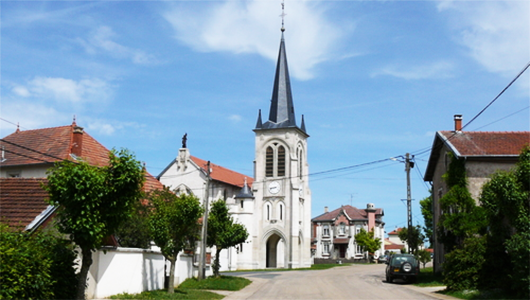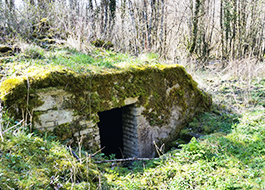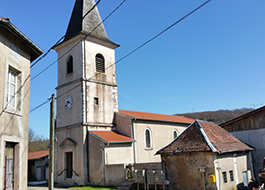Vilcey-sur-Trey
Durée visite : 20 minutes
Moyen : Pédestre
En 1504, le chevalier Nicolas de Heu, seigneur de Vilcey-sur-Trey, abandonne ses droits et propriétés dans cette localité. Ils reviennent aux religieux Prémontrés de Sainte-Marie-aux-Bois. Le 28 juin 1584, une habitante de Vilcey-sur-Trey, convaincue de sorcellerie est brûlée à Prény, siège de prévôté. En 1597, une autre femme de Vilcey a plus de chance. Accusée d’être une sorcière, elle réussit à s’enfuir et ne fut jamais retrouvée. Vers 1635, lors de la guerre de Trente Ans, les Suédois, alliés des Français, y portèrent la désolation. Ils saccagèrent l’abbaye de Sainte-Marie-aux-Bois. Pendant la Première Guerre mondiale, deux écrivains ont séjourné dans cette commune, le français Charles Péguy en 1914 et l’allemand Ernst Jünger en 1917. Ce village a été incendié par les troupes allemandes en retraite en 1944.
In 1504, the knight Nicolas de Heu, Lord of Vilcey-sur-Trey, gave up his rights and properties in this locality. They go back to the Premonstratensian religious of Sainte-Marie-aux-Bois. On June 28, 1584, a resident of Vilcey-sur-Trey, convicted of witchcraft, was burned in Prény, the provost’s seat. In 1597, another woman from Vilcey had better luck. Accused of being a witch, she managed to escape and was never found. Around 1635, during the Thirty Years’ War, the Swedes, allies of the French, brought desolation there. They sacked the abbey of Sainte-Marie-aux-Bois. During the First World War, two writers stayed in this town, the French Charles Péguy in 1914 and the German Ernst Jünger in 1917. This village was burned down by retreating German troops in 1944.
Im Jahr 1504 gab der Ritter Nicolas de Heu, Herr von Vilcey-sur-Trey, seine Rechte und Besitztümer an diesem Ort auf. Sie gehen auf die prämonstratensischen Ordensleute von Sainte-Marie-aux-Bois zurück. Am 28. Juni 1584 wurde ein wegen Hexerei verurteilter Einwohner von Vilcey-sur-Trey in Prény, dem Sitz des Provost, verbrannt. 1597 hatte eine andere Frau aus Vilcey mehr Glück. Sie wurde beschuldigt, eine Hexe zu sein, konnte jedoch fliehen und wurde nie gefunden. Um 1635, während des Dreißigjährigen Krieges, brachten die Schweden, Verbündete der Franzosen, dort Verwüstung. Sie plünderten die Abtei von Sainte-Marie-aux-Bois. Während des Ersten Weltkriegs blieben zwei Schriftsteller in dieser Stadt, der Franzose Charles Péguy 1914 und der Deutsche Ernst Jünger 1917. Dieses Dorf wurde 1944 durch den Rückzug deutscher Truppen niedergebrannt.

D’azur au chevron renversé d’or soutenu par une fasce ondée d’argent chargée d’une flèche de gueules.
Ce sont des armes parlantes : Le V d’or est l’initiale de Vilcey. La fasce ondée chargée d’une flèche (d’un trait) symbolise la rivière Trey.
Azure, a reversed chevron Or supported by a wavy fess Argent charged with an arrow Gules.
These are talking weapons: The Golden V is Vilcey’s initial. The wavy fascia loaded with an arrow (with a stroke) symbolizes the Trey River.
Azure, ein umgekehrter Chevron von Gold unterstützt von einem welligen Fess Argent, der mit einem Pfeil Gules aufgeladen ist.
Dies sind sprechende Waffen: Das Goldene V ist Vilceys Initiale. Die mit einem Pfeil (mit einem Strich) beladene Wellenfaszie symbolisiert den Trey River.
Les points de visites
.
Au cours des quatre années de guerre, les Allemands aménagèrent de nombreux abris dans ces vallons. Ceux-ci, creusés dans le sol, étaient recouverts d’une toiture faite de rondins ou de tôles ondulées, le tout recouvert de roche et de terre. Les sources furent captées et transformées en lavoir. La plupart de ces abris sont aujourd’hui effondrés. Un de ces abris est décrit par Ernst Jünger dans son livre Orages d’acier. Celui-ci était cantonné ici lors de son passage en septembre 1917.
La fontaine Kühlewein fut construite entre 1915 et 1916 par le 369e RI. Elle fut dédiée au lieutenant Von Kühlewein. Celui-ci commandait la 2e compagnie du Brigade Ersatz Bataillon 80. La fontaine fut construite après la fin des combats au Bois-le-Prêtre. Le cantonnement comprenait deux abris réalisés en béton. Le premier servit probablement de poste de commandement. Le deuxième ouvrage en béton est un poste de secours.
Deux moulins étaient présents dans le vallon, celui de Gaulange et celui de Jaillard. Le moulin de Gaulange était la propriété des moines de l’abbaye de Ste-Marie-aux-Bois. Détruit par les bombardements, il fut reconstruit après la guerre. Le moulin de Jaillard était le moulin de la seigneurie de Haye. Il fut exploité jusqu’en 1890. Ces caves servirent d’abri aux soldats allemands. En face du moulin, ils établirent un de leurs cimetières de secteur. les tombes furent transférées vers la nécropole de Thiaucourt en 1920. La Putter Quelle a été aménagée en lavoir pour les bottes et le linge. À l’origine, la cuve était couverte pour éviter que l’eau soit souillée. La terre ruisselait depuis le flanc du coteau. Elle était aussi projetée par les explosions d’obus. Elle doit son nom à un médecin d’état-major du 80e Brigade Ersatz Bataillon.
During the four years of the war, the Germans set up many shelters in these valleys. These, dug in the ground, were covered with a roof made of logs or corrugated iron, all covered with rock and earth. The sources were captured and transformed into a wash house. Most of these shelters have now collapsed. One of these shelters is described by Ernst Jünger in his book Storms of Steel. He was stationed here when he visited in September 1917.
The Kühlewein fountain was built between 1915 and 1916 by the 369th IR. It was dedicated to Lieutenant Von Kühlewein. He was in command of the 2nd company of the Ersatz Battalion 80 Brigade. The fountain was built after the end of the fighting in Bois-le-Prêtre. The cantonment included two shelters made of concrete. The first probably served as a command post. The second concrete structure is a first aid station.
Two mills were present in the valley, that of Gaulange and that of Jaillard. The Gaulange mill was the property of the monks of the abbey of Ste-Marie-aux-Bois. Destroyed by the bombardments, it was rebuilt after the war. The Jaillard mill was the mill of the seigneury of Haye. It was operated until 1890. These cellars served as shelter for German soldiers. In front of the mill, they established one of their sector cemeteries. the tombs were transferred to the necropolis of Thiaucourt in 1920. The Putter Quelle was converted into a wash house for boots and linen. Originally, the tank was covered to prevent the water from being contaminated. The earth streamed from the side of the hill. It was also thrown by the shell explosions. It owes its name to a staff doctor from the 80th Ersatz Brigade Battalion.
Während der vier Kriegsjahre errichteten die Deutschen in diesen Tälern viele Schutzräume. Diese in den Boden gegrabenen wurden mit einem Dach aus Baumstämmen oder Wellblech bedeckt, die alle mit Stein und Erde bedeckt waren. Die Quellen wurden erfasst und in ein Waschhaus umgewandelt. Die meisten dieser Unterstände sind inzwischen zusammengebrochen. Einer dieser Unterstände wird von Ernst Jünger in seinem Buch Storms of Steel beschrieben. Er war hier stationiert, als er im September 1917 besuchte.
Der Kühleweinbrunnen wurde zwischen 1915 und 1916 vom 369. IR gebaut. Es war Leutnant Von Kühlewein gewidmet. Er befehligte die 2. Kompanie der Brigade des Ersatzbataillons 80. Der Brunnen wurde nach dem Ende der Kämpfe in Bois-le-Prêtre gebaut. Der Kanton umfasste zwei Unterstände aus Beton. Der erste diente wahrscheinlich als Kommandoposten. Die zweite Betonkonstruktion ist eine Erste-Hilfe-Station.
Im Tal befanden sich zwei Mühlen, die von Gaulange und die von Jaillard. Die Gaulange-Mühle war Eigentum der Mönche der Abtei von Ste-Marie-aux-Bois. Durch die Bombardierungen zerstört, wurde es nach dem Krieg wieder aufgebaut. Die Jaillard-Mühle war die Mühle des Seigneury von Haye. Es wurde bis 1890 betrieben. Diese Keller dienten als Unterschlupf für deutsche Soldaten. Vor der Mühle errichteten sie einen ihrer Sektorfriedhöfe. Die Gräber wurden 1920 in die Nekropole von Thiaucourt überführt. Die Putter Quelle wurde in eine Wäscherei für Stiefel und Leinen umgewandelt. Ursprünglich war der Tank abgedeckt, um eine Kontamination des Wassers zu verhindern. Die Erde strömte von der Seite des Hügels. Es wurde auch durch die Granatenexplosionen geworfen. Es verdankt seinen Namen einem Stabsarzt des 80. Ersatzbrigadenbataillons.
.
.
L’église Saint-Martin de Vilcey date de la fin du XVIIIe siècle. Saint Martin de Tours est aussi nommé Martin le Miséricordieux. Il né dans l’Empire romain, plus précisément à Savaria, dans l’actuelle Hongrie, en 316. Il est mort à Candes, en Gaule, en 397. C’est l’un des principaux saints de la chrétienté. Légionnaire affecté en Gaule, à Amiens, un soir de l’hiver 334, il partage son manteau avec un déshérité transi de froid. Car il n’a déjà plus de solde après avoir généreusement distribué son argent. Il tranche son manteau ou tout du moins la doublure de sa pelisse. Le manteau appartient à l’armée, mais chaque soldat peut le doubler à l’intérieur par un tissu ou une fourrure à ses frais. La nuit suivante le Christ lui apparaît en songe, vêtu de ce même pan de manteau. Il a alors 18 ans. Le reste de son manteau, appelé cape sera placé plus tard, à la vénération des fidèles, dans une pièce dont le nom est à l’origine du mot chapelle. Il fut évêque de Tours. Son culte se répand partout en Europe occidentale, depuis l’Italie, puis surtout en Gaule, où il devient le patron des dynasties mérovingienne et carolingienne.
The Saint-Martin de Vilcey church dates from the end of the 18th century. Saint Martin of Tours is also called Martin the Merciful. He was born in the Roman Empire, more precisely in Savaria, in present-day Hungary, in 316. He died in Candes, in Gaul, in 397. He is one of the principal saints of Christendom. A legionary posted to Gaul, at Amiens, one winter evening in 334, he shared his coat with a disinherited, frozen with cold. Because he already has no balance after generously giving out his money. He cuts off his coat or at least the lining of his pelisse. The coat belongs to the army, but each soldier can line it inside with fabric or fur at his own expense. The following night Christ appeared to her in a dream, dressed in the same piece of cloak. He was then 18 years old. The rest of his mantle, called a cape, will be placed later, for the worship of the faithful, in a room whose name is the origin of the word chapel. He was bishop of Tours. His cult spread throughout Western Europe, from Italy, then especially in Gaul, where he became the patron of the Merovingian and Carolingian dynasties.
Die Kirche Saint-Martin de Vilcey stammt aus dem Ende des 18. Jahrhunderts. Der Heilige Martin von Tours wird auch Martin der Barmherzige genannt. Er wurde 316 im Römischen Reich, genauer gesagt in Savaria im heutigen Ungarn, geboren. Er starb 397 in Candes in Gallien. Er ist einer der Hauptheiligen der Christenheit. Als Legionär, der an einem Winterabend im Jahr 334 nach Gallien in Amiens entsandt worden war, teilte er seinen Mantel mit einem enterbten, vor Kälte gefrorenen. Weil er bereits kein Guthaben hat, nachdem er sein Geld großzügig ausgegeben hat. Er schneidet seinen Mantel oder zumindest das Futter seiner Pelisse ab. Der Mantel gehört der Armee, aber jeder Soldat kann ihn auf eigene Kosten mit Stoff oder Fell auskleiden. In der folgenden Nacht erschien ihr Christus in einem Traum, gekleidet in denselben Umhang. Er war damals 18 Jahre alt. Der Rest seines Mantels, Kap genannt, wird später zur Verehrung der Gläubigen in einen Raum gestellt, dessen Name der Ursprung des Wortes Kapelle ist. Er war Bischof von Tours. Sein Kult verbreitete sich in ganz Westeuropa, von Italien aus, insbesondere in Gallien, wo er der Patron der Merowinger- und Karolinger-Dynastien wurde.









